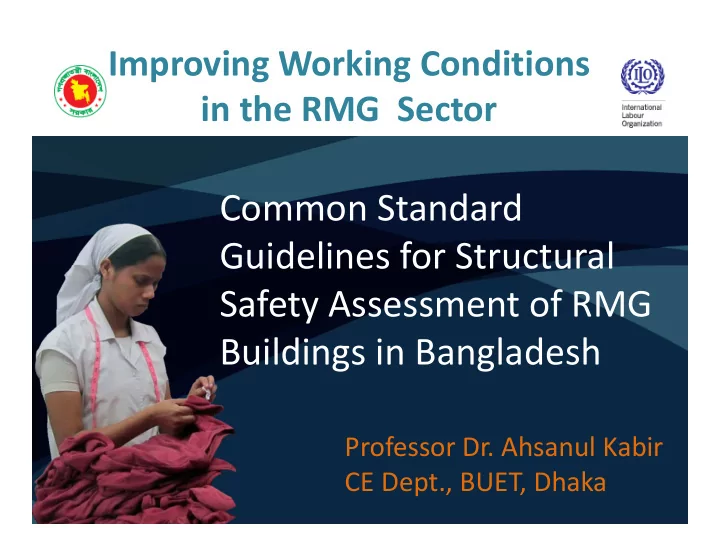

Improving Working Conditions in the RMG Sector Common Standard Guidelines for Structural Safety Assessment of RMG Buildings in Bangladesh Professor Dr. Ahsanul Kabir CE Dept., BUET, Dhaka
Safety Assessment Stages Stage 1: Preliminary visual inspection (based on visual observation of distress and some rudimentary calculation) Stage 2: Detail engineering investigation (based on field and laboratory testing followed by analysis and design checking) Stage 3: Design of Retrofit Scheme (based on stage 2 findings)
Visual Inspection (Stage-1) ESTABLISH AIMS AND REQUIREMENTS DOCUMENT SURVEY SITE VISIT FOR VISUAL INSPECTION & INFORMATION STAGE 1 COLLECTION PRELIMINARY CALCULATION OF CAPACITY REPORTING Check if detail analysis is reqd.? If yes stage 2 reqd.
Need for Common Guidelines Structural Assessment is a process to evaluate the existing structure in terms of withstanding the current loads to which it is subjected and probable loads that it is going to experience in future time : • Assessment of Existing Building is different from design of a new building • Assessment depends on Engineering judgment of person/s and experience
Need for Common Guidelines (p/2) • Compliance to Building code may not be met, yet the building can serve the present purpose with low risk • Different groups may differ in their opinions regarding safety • A common guideline and a central body is essential to remove the differences
Assessment Records Beam Column Ceiling �����������������������������������������
Assessment Guidelines • Methods for Design Adequacy Assessment • Safety of Foundations and Pile Supported Structures • Safety of RC Structures • Loading, Load Combination and Restricted Reduced Loading Live Load and Lateral Loads, Load Combinations, Prescribe Reduced Loads • Assessment of Material Strength
Assessment Guidelines (p/2) • Durability and Maintenance efflorescence and dampness; Water logging • Additions and Alterations May be allowed if comply with BNBC. • Equipment and Fixtures All non-structural elements suspended from, attached to, or resting atop the structure shall be anchored and braced to resist earthquake forces. • Vulnerable/Critical Members Slender Columns, flat plates and footings with inadequate thickness for shear etc. are Vulnerable Critical Members Distressed Members
Assessment Guidelines (p/3) • Certification after Retrofitting • Further Construction • New Construction of RMG Factory • Other Brand/Buyer Requirements * • Structures with no Proper Documentation * To be allowed by the national committee
Assessment Guidelines (p/4) Qualification of Engineering Team who can Make Assessment and Provide Certification At least two qualified Engineers (one structural and other geotechnical engineer). Minimum qualification reqd. for applying for registration as a team: • B. Sc Engg. (Civil or Civil and Structural or Civil and Geotechnical) from a recognized university • IEB Member/Fellow • More than 10 years of Professional Experience • Practicing as a Structural/Geotechnical Engineer or worked in consulting company/ institution. Registration renewable every 3 years
Assessment Guidelines (p/5) Visual Assessment to suggest 2 nd stage Is the structure properly designed by 1. Yes/No professionals? Is the structure free from any visible distress If all these 2. (progressive cracking) in main load carrying Yes/No answers are yes, members? Preliminary Is the foundation adequate (in bearing and 3. Assessment may Yes/No settlement) considering the sub soil condition? suffice. Detail Is the structure out of risk due to presence of 4. Engg Assessment critical structural element (slender column, flat Yes/No necessary, if plate, transfer girder, foundation weakness)? gross Is the vertical and lateral load resisting system 5. inadequacies Yes/No (load path) apparently adequate? exist; building Is the structure free from cracks in column 6. may remain Yes/No and/or beam indicating foundation yielding? operational. Was the building had minimum standard of civil 7. Yes/No work supervision during construction? /Uncertain
Assessment Guidelines (p/6) References: 1. Bangladesh National Building Code (BNBC), 2006, 2. ACI 437R-03, Strength Evaluation of Existing Buildings. 3. ASTM 2018, Standard Guide for Property Condition Assessments: 4. ACI 201.1R-08 Guide for Conducting Visual Inspection of Concrete in Service. 5. ACI 318-11, Building Code Requirements for Structural Concrete.
Improving Working Conditions in the RMG Sector
Recommend
More recommend